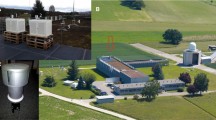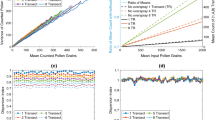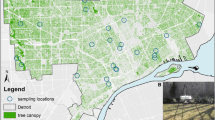Abstract
Although considered a golden standard in aerobiology, continuous long-term sampling of bioaerosols is resource demanding. The aim of this study was to explore whether, if needed, intermittent sampling could replace the continuous one without major loss of information. Hourly pollen concentrations obtained by averaging 56, 28, 14 and 7 equidistantly distributed 1.07-min concentrations of Ambrosia airborne pollen were compared. The analysis revealed that majority of information on trends and magnitude in hourly concentrations is captured even if the sampling is not continuous. The correlations were high for all intermittent sampling arrangements, but absolute percentage error increased with the decrease in samples used for calculating hourly concentration.
Similar content being viewed by others
Explore related subjects
Discover the latest articles, news and stories from top researchers in related subjects.Avoid common mistakes on your manuscript.
Continuous sampling is the golden standard in aerobiology. Hirst-type volumetric samplers allow obtaining hourly concentrations of measured particles (Hirst 1952), which are then averaged to get daily concentrations (Galán et al. 2014). However, continuous sampling of high volumes and operation in environments with high quantity of suspended particles would lead to saturation of the sampling medium which limits the sampling time and prevents long-term continuous monitoring. This is the most prominent in impactors and cyclone samplers where impaction surface is small (Cox and Wathes 1995).
Similarly, the resources of operational automatic bioaerosol monitors are limited. For example, BAA500 uses magazines for sample carriers (Oteros et al. 2015), while the lifetime of UV lasers, commonly used in automated flow cytometers such as PAA-500 (Crouzy et al. 2016) and WIBS-4 (O’Connor et al. 2014), has limited number of shots. This notably increases the maintenance cost for measurements in conditions with high concentrations of airborne particles (e.g. vicinity of source) and during long-term monitoring. The aim of this study was to explore to what extent replacing continuous by intermittent sampling affects variability in hourly pollen concentrations.
The concentrations of Ambrosia airborne pollen, expressed as pollen grains per cubic metre of air (pg m−3), were obtained from the experiment dedicated to exploring Ambrosia pollen emission characteristics (Sikoparija et al. 2018).
Measurements of airborne pollen concentrations at 0.5 m and 5.5 m above the Ambrosia pollen source allowed simultaneous collection of different quantities of suspended pollen in the atmosphere. The length of the sampling surface, the duration of sampling and the width of the sampling orifice determine the temporal resolution of collected samples. In commonly used Hirst-type samplers (e.g. Lanzoni VPPS2000, Lanzoni VPPS2010, Burkard “Pollen and Spore trap”, Burkard Scientific “Pollen and Spore trap”, Burkard Scientific “SporeWatch”), the perimeter of the drum that holds the tape for sampling is 336 mm and the sampling orifice is 14 mm × 2 mm. Therefore, full drum rotation enables taking maximum 168 temporally resolved samples, each being collected on 2 mm length of sampling surface (336 mm/2 mm = 168 samples of 2 mm).
Sampling was performed by using Burkard Scientific SporeWatch samplers in which clock device enables adjusting the time for full rotation of the drum. For 12 h (6–12 AM CEST on 1 September 2015 and 6–12 AM CEST 2 September 2015), the full rotation of the drum was set to 3 h (180 min) which provided that each 2 mm of sampling surface corresponds to 1.07 min sampling (180 min/168 samples = 1.07 min). As a result, 56 samples per hour (each giving 1.07-min pollen concentration) were collected. Hourly pollen concentrations calculated by averaging 56, 28, 14 and 7 equidistantly distributed 1.07-min concentrations were compared (Fig. 1). Since Kolmogorov–Smirnov test confirmed normal distribution of analysed hourly concentrations, Pearson product–moment correlation coefficients (r) were calculated to asses direction and strength of relationships (i.e. simultaneous increase or decrease) between concentrations obtained by continuous sampling and those from averaging 28, 14 and 7 equidistantly distributed 1.07-min concentrations. Paired sample t test was used to compare difference in the quantity of pollen recorded by continuous and different intermittent sampling approaches. The difference in magnitude of hourly pollen concentrations was described by absolute percentage error (%). Its dependence from the quantity of pollen and coefficient of variation (%) in 1.07-min values per hour was explored by regression analysis, i.e. adjusted coefficient of determination (adjusted R2) and probability (p) values.
The distribution of samples used for calculating hourly pollen concentration (each black slice corresponds to one 1.07-min sample): a 56 samples—continuously, b 28 samples per hour—one sample followed by 1.07-min break, c 14 samples per hour—one sample followed by 3.21-min break, d 7 samples per hour—one sample followed by 7.49-min break
Although earlier study of high-resolution pollen concentrations revealed notable variance in atmospheric pollen concentrations (Sikoparija et al. 2018), this variability is usually hidden by averaging data to 1-h resolution. There is notably less pollen recorded at 5.5 m above the source, but the signal correlated with the values recorded below at 0.5 m above the source (Fig. 2). The analysed hours captured the range of variability in the magnitude of hourly pollen concentrations, from 101 to 46,948 pg m−3. Hours with both high (280%) and low coefficient of variation (85%) of 1.07-min concentrations were explored. Also, hours when no pollen is recorded in more than half 1.07-min concentrations were analysed. The comparison of average hourly concentrations confirmed that majority of information on trends and magnitude is captured even if the sampling is not continuous.
The analysis revealed high positive statistically significant correlations between hourly concentrations obtained by continuous sampling and those obtained by equidistant 28 samples (Pearson r = 0.993), 14 samples (Pearson r = 0.970) and 7 samples (Pearson r = 0.849) per hour, but as expected the correlation decreases with the decrease in number of samples taken for calculating average hourly concentration. In addition, paired sample t-test confirmed that the differences in the average pollen concentrations obtained by continuous and intermittent sampling were not statistically significant. Absolute percentage error increased with the decrease in samples used for calculating hourly concentration, on average 10%, 20% and 39% for 28, 14 and 7 samples per hour, respectively. We observed the highest absolute percentage error of 143% for the case of 7 samples per hour. Further, regression analysis showed that the absolute percentage error does not depend on the amount of pollen in the air but for all intermittent sampling approaches it depends on the degree of variation in 1.07-min concentrations during the given hour (Fig. 3).
This study confirmed that for the assessment of hourly pollen concentrations, continuous sampling can be replaced by the intermittent one. Already 14, equidistantly arranged, 1.07-min samples per hour were enough for capturing both the magnitude and the trends of hourly Ambrosia pollen concentrations. The effect of sampling on hourly pollen concentrations should be confirmed for other pollen types, but already these results support intermittent sampling as the mean for saving resources (e.g. laser shots, sample carriers, sampling medium) in long-term aerobiological monitoring.
References
Cox, C. S., & Wathes, C. M. (1995). Bioaerosols handbook (p. 656). Boca Raton: CRC Press. ISBN 9780873716154.
Crouzy, B., Stella, M., Konzelmann, T., Calpini, B., & Clot, B. (2016). All-optical automatic pollen identification: towards an operational system. Atmospheric Environment,140, 202–212.
Galán, C., Smith, M., Thibaudon, M., Frenguelli, G., Oteros, J., Gehrig, R., et al. (2014). Pollen monitoring: Minimum requirements and reproducibility of analysis. Aerobiologia,30, 385–395.
Hirst, J. M. (1952). An automatic volumetric spore trap. Annals of Applied Biology,39, 257–265.
O’Connor, D. J., Healy, D. A., Hellebust, D., Buters, J. T. M., & Sodeau, J. R. (2014). Using the WIBS-4 (waveband integrated bioaerosol sensor) technique for the on-line detection of pollen grains. Aerosol Science and Technology,48(4), 341–349.
Oteros, J., Pusch, G., Weichenmeier, I., Heimann, U., Möller, R., Röseler, S., et al. (2015). Automatic and online pollen monitoring. International Archives of Allergy and Immunology,167(3), 158–166.
Sikoparija, B., Mimić, G., Panić, M., Marko, O., Radišić, P., Pejak-Šikoparija, T., et al. (2018). High temporal resolution of airborne Ambrosia pollen measurements above the source reveals emission characteristics. Atmospheric Environment,192, 13–23.
Acknowledgements
This work was partly financed by the Swiss National Science Foundation through the SCOPES JRP No. IZ73Z0_152348 and RealForAll Project (2017HR-RS151) co-financed by the Interreg IPA Cross-border Cooperation programme Croatia—Serbia 2014–2020 and Provincial secretariat for Science, Autonomous Province Vojvodina, Republic of Serbia (Contract No. 102-401-337/2017-02-4-35-8).
Author information
Authors and Affiliations
Corresponding author
Rights and permissions
About this article
Cite this article
Sikoparija, B., Mimić, G., Matavulj, P. et al. Short communication: Do we need continuous sampling to capture variability of hourly pollen concentrations?. Aerobiologia 36, 3–7 (2020). https://doi.org/10.1007/s10453-019-09575-1
Received:
Accepted:
Published:
Issue Date:
DOI: https://doi.org/10.1007/s10453-019-09575-1







